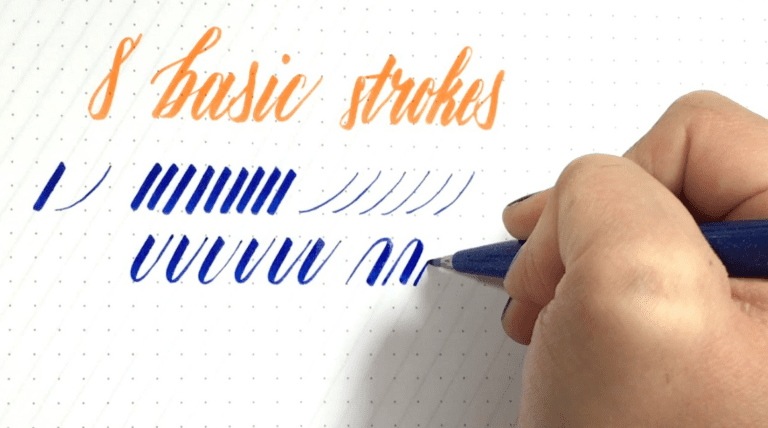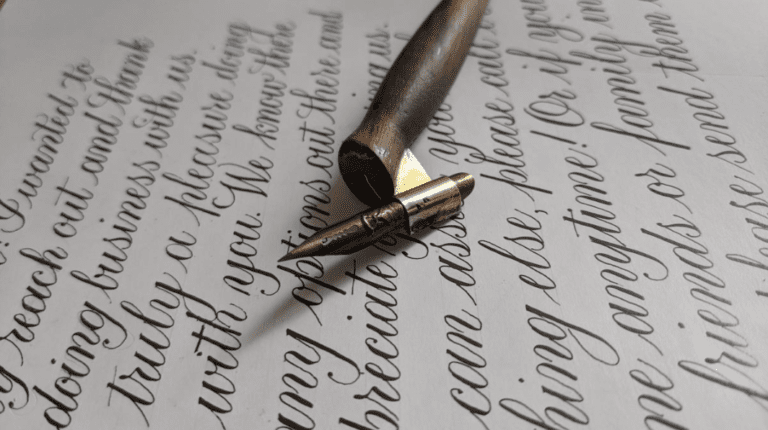
How to tell the difference between hand lettering, calligraphy, and typography
In this post, you’ll learn the difference between hand lettering, calligraphy, and typography, so you can understand where they come from and why it’s important to tell them apart.
Are you confused by the difference between handwriting and calligraphy?
Don’t worry, you’re not alone.

These terms are often used interchangeably, which can certainly cause some confusion for those who have no experience with either of them.
When you’re just starting out, you just see the different styles of letters and group the different styles as hand lettering or calligraphy.
But there’s more to these techniques than just how letters look.
In this post, you’ll learn the difference between hand lettering, calligraphy, and typography, how they’re made, and what tools each technique requires.
Believe in the confusion between the balloon art form with hash tags, as similar topics are commonly tagged together and the three are interrelated. It’s well known in social media that you don’t have to be right when you hash tag anything, so naturally the lines between them get a little blurry over time. I should not, then, despair of the fact that, as many of us who have delved into calligraphy, hand-lettering or typography, have discovered the art form through such channels. This is not a great problem to solve, but in principle it is important to distinguish between the three terms.

What is Hand Lettering?
Hand lettering is basically drawing letters using as many strokes as possible rather than typing them using a keyboard.
This is different from calligraphy, where we use basic strokes to create letters and words. You often have more control with handwritten letters than with calligraphy. For this reason in particular, hand calligraphy can be a great alternative for projects that are too large for calligraphy, such as large chalkboards and other signage.
Every letter writer has a unique style and whenever a handwritten alphabet is created, it should not be used in different situations. The alphabet created is designed with a specific project in mind, and only that project.
Although it does not have strict rules, hand lettering still follows some basic rules such as readability, balance, composition, letter structure, etc.
When writing letters by hand, you are often working with under drawings or sketches. Another common thing is to mix different script types and different letter heights within the same word or phrase.
Sometimes the letters are distorted, stretched, or changed in other large ways to fit the design – but this is not done using a program, it is simply done by hand with a brush pen.
In Europe, it began as a way to copy books and manuscripts. Then organically became more and more elaborate and decorative. First letters and curved descents turned into curving and bending curves decorating the entire text. After some time, calligraphy evolved into a written art form, with fluctuating popularity until now.
Asia and the Middle East were also very influential in the beginning of calligraphy. For centuries, it has been considered an art form, like sculpture or painting.
What Tools are used for Hand Lettering?

Let’s take a look at the types of tools most commonly used for hand lettering:
Pencil – Essential when it comes to sketching/drawing your sketches. When writing letters by hand, you’ll be working a lot with a pencil. When working with a pencil, it can always be erased, whereas once you ink it, you’re done and there’s no going back.
Paper – Using lined or dotted sheets can be very helpful to keep your lines straight and to make sure your letters are the same size when practicing.
Ruler – The ruler will not only help you draw straight lines, but it plays an important role when it comes to creating a base for your piece. A rolling roller has a wheel and allows you to draw parallel lines quickly making it a time saver when it comes to drawing grids for your letters.
Markers – The ultimate essential tool you need for hand lettering. Used to outline and fill in your shapes, it’s definitely a must-have for any type of hand lettering artwork.
What is Calligraphy?
Calligraphy is the art of creating beautiful handwriting using a dip pen with a nib and ink to create thick and thin lines in a single stroke using varying degrees of pressure.
The main difference between calligraphy and hand lettering is that hand calligraphy is completely free in its process.
When writing letters by hand, you can change the size of the letters, the type of script and everything about the script and calligraphy. which is being used and the type of script being written.
Hand lettering is also drawing letters while calligraphy, on the other hand, is the traditional way of writing letters. Lines are usually done in one fluid motion with no under drawing and you usually stick to a script type.
Also, calligraphy can be used when writing letters or long texts, unlike hand lettering, which is almost exclusively used for headlines, logos or short visual sentences.
What Tools are Used for Calligraphy?
Depending on the script you want to execute, you can choose from different tools:
Dip pens – traditional calligraphy tool used for scripts such as copper plate, Spencerian and even modern calligraphy.
Brush Pen – Also used for calligraphy and is usually a cheaper and more accessible tool for beginners – also known as brush lettering.
Flat nib pens – used for calligraphy scripts such as Gothic calligraphy, italics, uncials, Roman capitals and more.
Fountain pens – can also be used for calligraphy but are more suitable for penmanship as most of them do not have the default flexible nib needed to create thick and thin lines.
What is Brush Calligraphy?
Brush calligraphy is similar to traditional calligraphy with the main difference being the tool used to write. Brush calligraphy is done using brush pens as well as regular brushes for watercolors while traditional calligraphy is done using dip pen and ink.
Brush calligraphy and traditional calligraphy share the same basic principles of having thick downstrokes and thin upstrokes, however, traditional calligraphic scripts such as copperplate and Spencerian are more commonly executed with traditional dip pen and ink.
Brush calligraphy is actually a traditional Chinese style, which is why many major brush pen brands come from Japan and China.
What is Faux Calligraphy?
False calligraphy can be created with any standard writing tool such as a ballpoint pen, chalk, or marker and provides a wonderful introduction to dip pen calligraphy.
Traditional calligraphy plays with the contrast between thin and thick strokes within letters, but in faux calligraphy, you fake this effect by copying our downward strokes, so they look thicker than the upward strokes. .
What is Chalk Lettering?
Chalk lettering is an art form that mainly involves creating letter pieces with chalk using a chalkboard.
When you’re drawing with chalk, you follow pretty much the same techniques as you do when writing with traditional tools.
The only difference is that you can use shading and techniques that can only be achieved with chalk.
What is typography?
Now coming to the typography. The difference between hand lettering and calligraphy is more blurred than the difference between the two and typography. Even so, it can still be confusing for some people. This is because within typography there are calligraphy and handwritten styles.
First, what is typography? Typography is the technique of arranging type to create letters, words, and sentences on a piece of written text of any size or length. Type, in its original definition, is a set of metal rectangles with letters on them. These, in turn, were used in a printing press to print the text.
Typography is the art and technique of arranging written language to make it readable and attractive when displayed and has nothing to do with actually drawing or writing letters.
In typography, every letter will look exactly the same, for example, every letter “a” in the same font will be an exact copy. Because the fonts are digitized. While the letter “a” of the same script with calligraphy and hand lettering will look very similar but not exactly the same.
In calligraphy or hand lettering, each letter will be written or drawn by hand while typography is mainly used in print or advertising and online.
Typography is neither hand calligraphy nor calligraphy. Typography is what you see right now – the typeface on the screen. Typefaces and fonts are considered typography and are created by type designers whose primary focus is to create type such that, regardless of the layout, the letterforms are exactly the same.
Printing presses with type are no longer commonly used, as we use computers. The word typography, though, is still very much in use. This is where things get confusing. The first collections of this type were designed to resemble the letters in use at the time, which were primarily calligraphic. This was when calligraphy made the leap to typography.
When typography went digital, the font craze began. Nowadays fonts are confused with typography, type families are confused with hand lettering and so on.
Common Mistakes
Calligraphy and calligraphy are not defined by the tools we are using to create the letters, but by the method, we are using to create them.
To reiterate the points made above:
Lettering is the necessary number of edits, edits and generally drawing letters generated from a number of thumb sketch ideas.
Calligraphy is the writing of letters in one stroke or the deconstruction of several strokes, with no erasure or readjustment required.
I think the misunderstanding comes because some people associate pointed and flat pens with calligraphy, so when they see someone using a different tool, they automatically think it’s something else. , for example, vowels.
Another factor that contributes to this confusion is the digitization of finished artworks. Hand letters and calligraphy can be scanned into a computer, polished and digitized, often converted into a font or typographic poster. Doing so can make the letters or calligraphy appear like a font when it was actually created by hand.
The difference between hand lettering, calligraphy and typography may not seem that important to you. But if you’re at all interested in learning how to use these sources, it’s important to know how they differ from one another.
You want to know what you’re talking about when you talk to other hand-lettering artists, calligraphers, and type designers, especially if you’re trying to break into these fields. Because using these terms interchangeably makes you look unprofessional, and can seriously discredit you. fame as an artist.
I hope this post was helpful, and that you now have a better understanding of the difference between hand lettering, calligraphy and typography.
Do you have more questions? Leave your questions in the comments and I’ll do my best to answer them!





